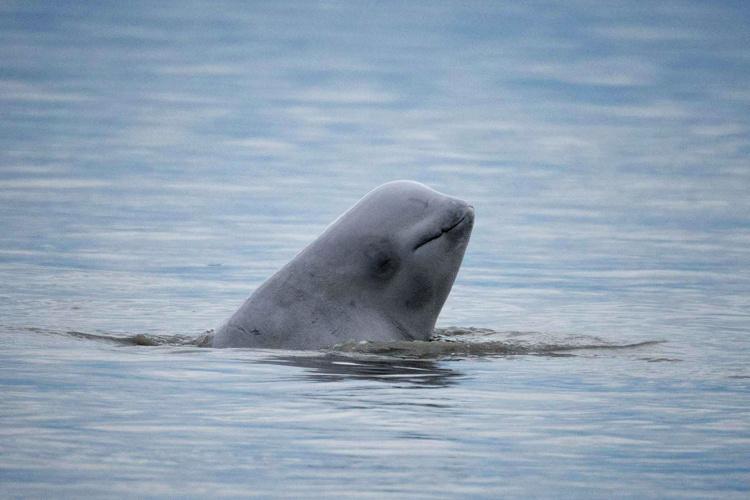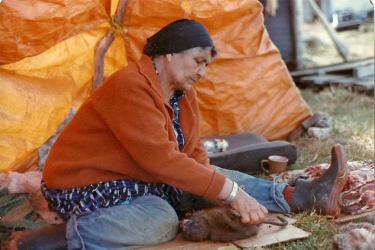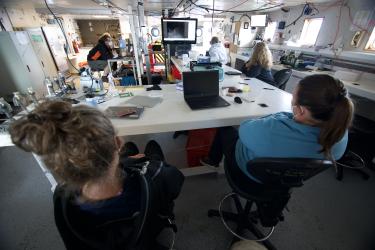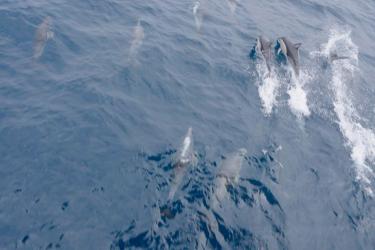Eagle Bay defeated us 2 days in a row, but on the third day we got it right. We woke up for our last day on the water for the project this year not expecting much, as the weather forecast was not great. It was still too windy to go out to the Susitna Delta, but Knik Arm was calm, so off we went, hoping the rain would let up. We thought we had the pattern down, now that we could see that many of the whales were moving into upper Knik Arm to forage at high tide this week. We had to be ready early on both the falling tide and the rising tide, as the whales were transiting Eagle Bay very quickly both coming and going.
We got up to Eagle Bay earlier in the tidal cycle on the falling tide. Even though there were whales already staging in the No-Fly zone south of the Bay, we got into Eagle Bay in time to meet a group of about 30 whales coming through. Jake and Hollis were able to get 3 quick flights in with this group.
Then we had to wait out the tide again. We spent a few hours drifting through the whales with the engine off, taking photo-identification shots, and enjoying the sounds of the whales. Then we moved up into Eagle Bay on the rising tide ahead of the whales and were ready when they came through. We got 4 flights in before the whales moved too far up into Knik Arm, and we didn’t have any drama in the standing waves at the north end of the Bay. It made us feel like we had kind of figured things out, at least for this week. Undoubtedly the whales change their behavior constantly with the changes in fish runs they are following. However at least today, we were able to get in 7 flights with 966 hexacopter photographs.
So at the end of Leg 2, I guess we proved that Leg 1 wasn’t a fluke. The weather was not quite as nice, but we still managed 31 flights this leg, and nearly as many photos as Leg 1.
The overall numbers over both legs are a little bit staggering, at least to me. We were able to get out on the water on 10 days, covered 636 nautical miles, and found 19 groups of belugas.
Hollis and Jake logged a total of 67 flights, with over 11 hours of flight time, and took 16,016 photographs from the hexacopter. I took 18,769 photographs of belugas (or empty water!) from the boat. Yes, in case you were wondering, my right index finger was a little sore. I looked it up, and the shutter in my camera is rated for ~150,000 photos. That means I used up 13% of my camera’s expected shutter life on one project! Yikes. I have never taken this many photos so quickly. I hope the camera holds out for a few more years.
With the wrap-up of the field work, we won’t be posting as frequently here, but we will try to post something when we have a bit more of a summary of the data, and we will also try to post some preliminary looks and results when we start actually measuring whales in the photographs, so we should have at least two more blog entries over the next couple of months.
Meet the Blogger
Paul Wade is a Research Fisheries Biologist at NOAA Fisheries’ Alaska Fisheries Science Center’s Marine Mammal Laboratory and project lead.
Paul joined the Lab’s Cetacean Assessment and Ecology Program in 1996, after completing a Ph.D. at Scripps Institution of Oceanography, and a NRC Postdoctoral Fellowship at the Southwest Fisheries Science Center. He has conducted killer whale research in the Aleutian Islands since 2001, and recently took over as head of Cook Inlet Beluga Whale research for the Lab.
Photographs are taken under MMPA Permit #20465. This study is a collaboration between NOAA Fisheries Alaska Fisheries Science Center’s Marine Mammal Laboratory, the Cetacean Health and Life History Program at NOAA Fisheries’ Southwest Fisheries Science Center, and the Alaska Department of Fish and Game (ADF&G).







